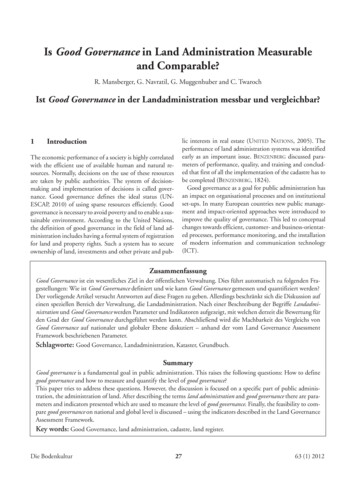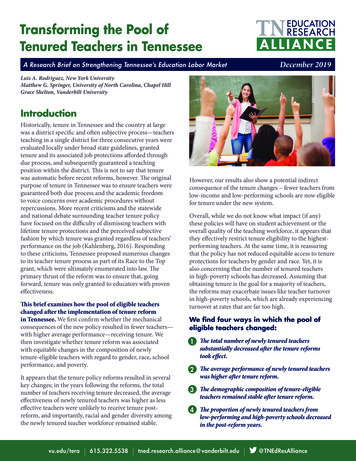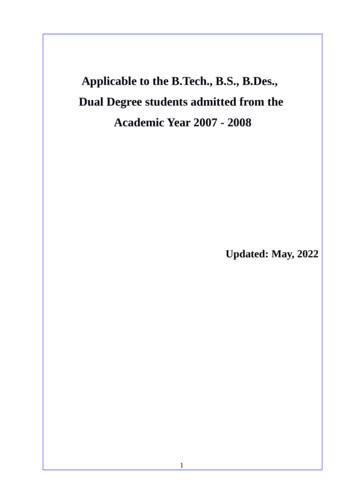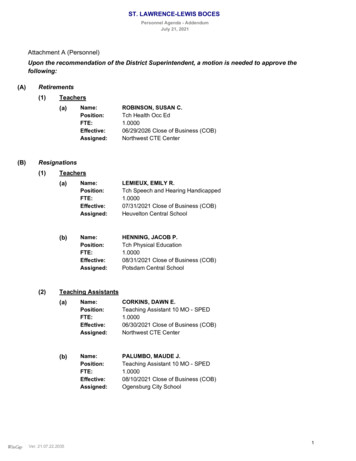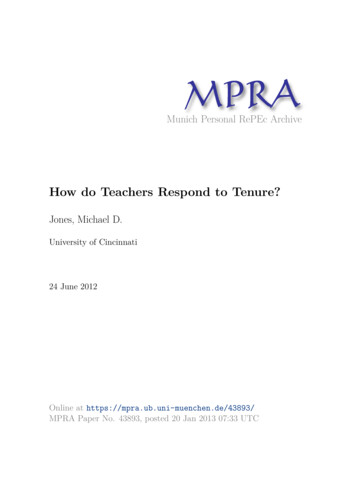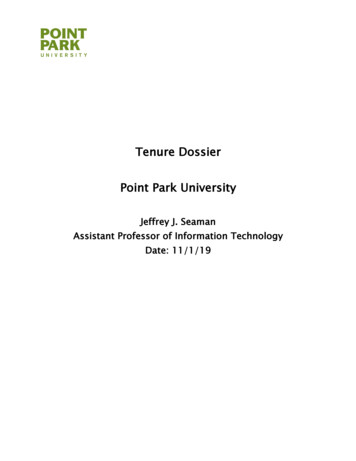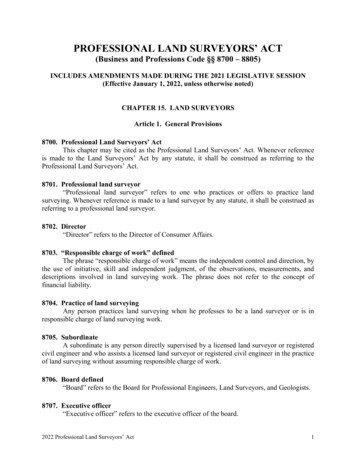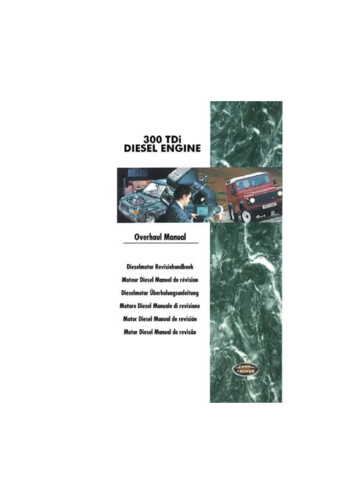
Transcription
Asia-Pacific Environment Monograph 3Customary Land Tenureand Registration in Australiaand Papua New Guinea:Anthropological Perspectives
Asia-Pacific Environment Monograph 3Customary Land Tenureand Registration in Australiaand Papua New Guinea:Anthropological PerspectivesEdited by James F. Weinerand Katie Glaskin
Published by ANU E PressThe Australian National UniversityCanberra ACT 0200, AustraliaEmail: anuepress@anu.edu.auThis title is also available online at: http://epress.anu.edu.au/customary citation.htmlNational Library of AustraliaCataloguing-in-Publication entryCustomary land tenure and registration in Australia andPapua New Guinea : anthropological perspectives.Bibliography.ISBN 9781921313264 (pbk.)ISBN 9781921313271 (online)1. Aboriginal Australians - Land tenure - Social aspects Australia. 2. Papuans - Land tenure - Social aspects Papua New Guinea. 3. Land titles - Registration andtransfer - Australia. 4. Land titles - Registration andtransfer - Papua New Guinea. 5. Land use - History Australia. 6. Land use - History - Papua New Guinea. I.Weiner, James F. II. Glaskin, Katie. (Series : APEMMonographs Series).306.32All rights reserved. No part of this publication may be reproduced, stored in aretrieval system or transmitted in any form or by any means, electronic, mechanical,photocopying or otherwise, without the prior permission of the publisher.Cover design by Duncan Beard.Cover photograph: Landowner of Goare Village, Goaribari Island, Gulf Province,Papua New Guinea (photo by James F. Weiner).This edition 2007 ANU E Press
Table of . Customary Land Tenure and Registration in Papua New Guinea andAustralia: Anthropological Perspectives, James F. Weiner andKatie Glaskin12. A Legal Regime for Issuing Group Titles to Customary Land: Lessonsfrom the East Sepik, Jim Fingleton153. Land, Customary and Non-Customary, in East New Britain,Keir Martin394. Clan-Finding, Clan-Making and the Politics of Identity in a Papua NewGuinea Mining Project, Dan Jorgensen575. From Agency to Agents: Forging Landowner Identities in Porgera,Alex Golub736. Incorporating Huli: Lessons from the Hides Licence Area,Laurence Goldman977. The Foi Incorporated Land Group: Groupand Collective Actionin the Kutubu Oil Project Area, Papua New Guinea, James F. Weiner1178. Local Custom and the Art of Land Group Boundary Maintenance inPapua New Guinea, Colin Filer1359. Determinacy of Groups and the ‘Owned Commons’ in Papua New Guineaand Torres Strait, John Burton17510. Outstation Incorporation as Precursor to a Prescribed Body Corporate,Katie Glaskin19911. The Measure of Dreams, Derek Elias22312. Laws and Strategies: The Contest to Protect Aboriginal Interests atCoronation Hill, Robert Levitus24713. A Regional Approach to Managing Aboriginal Land Title on Cape York,Paul Memmott, Peter Blackwood and Scott McDougall273Index299v
List of FiguresFigure 4-1: Nenataman location map.Figure 4-2: Topographical and site map of Nenataman.Figure 6-1: Percentage of landowner households dissatisfied withdifferent types of landowner organisation, 1998–2005.Figure 6-2: Petroleum Development Licence areas in PNG.Figure 6-3: A simplified model of the Huli descent and residence system.Figure 6-4: Zone ILGs proposed for the Hides licence area (PDL 1).Figure 6-5: Zone ILG structure proposed for the Hides licence area.Figure 6-6: Landowner preferences for benefit distribution, 2005.Figure 9-1: Area of common interest at Hidden Valley.Figure 9-2: Approximate number of signatories for ‘Nauti’ by yearFigure 10-1: Approximate location of outstation groups in 2001.Figure 10-2: General locations of Bardi and Jawi buru.Figure 11-1: Diagram depicting places of significance for the Warlpiriin relation to the licence area in initial year of exploration.Figure 11-2: Diagram depicting places of significance for the Warlpiriin second year of exploration with reduced licence area.Figure 11-3: Diagram depicting broader areas of importance for Walpiriin relation to the exploration licence area in initial year of exploration.Figure 11-4: Diagram depicting mining lease area in relation to areasof significance for Walpiri in the fifth year of mining.Figure 12-1: Kakadu National Park, showing Coronation Hill andreduced (post-1989) Conservation Zone.Figure 12-2: Kakadu National Park, showing stages of declaration andthe original Conservation Zone.Figure 13-1: Cape York Native Title Representative Body’s area ofadministration and the subregions of Wik and Coen.Figure 13-2: Wik subregion model.Figure 13-3: Coen subregion 42252254276288291vii
List of TablesTable 6-1: ILGs in petroleum licence areas, October 2004Table 9-1: Distribution of living descendants of the ‘Nauti’ constituentpatrilines of Equta patronymic by village (in 2000)Table 9-2: Some attributes related to commons ownership in four casesin Torres Strait and Papua New GuineaTable 13-1: Tenures on Cape York Peninsula showing potential foroverlapping Aboriginal ownershipTable 13-2: Model of harmonised rules for a PBC as trustee of a Land Trustviii103187189279283
ForewordAnthropologists 50 years ago would probably have regarded a collaborativepresentation of essays on indigenous land tenure in Australia and Papua NewGuinea (PNG) as a dubious undertaking, if not a category error. Aboriginal andMelanesian systems were functionally distinct, one adapted to the needs of ahunting and gathering economy, the other to sedentary horticulture. Going backanother 50 years, such a conjunction would have been intelligible only if itspurpose was to exhibit lower and higher stages in cultural evolution. As theauthors of the present volume are not motivated by a desire either to overturnfunctionalism or advance evolutionism, what brings them together in commoncause?An important clue is to be found in the curious fact that the Native Title Actof 1993, passed by the Federal Government on behalf of the indigenous peopleof Australia, grew directly out of a High Court action by three Torres StraitIslanders whose ancestors probably came from PNG and whose peopletraditionally lived as subsistence cultivators. In the course of documenting thedenigration of Aborigines in colonial legal history, Justice Brennan made it clearhe would have no sympathy with any attempt to represent the plaintiffs asbelonging to a higher level of native society than any that existed on the mainland(Bartlett 1993: 27). His colleague Justice Toohey acknowledged significant culturaldifferences between the two peoples but insisted that the principles relevant toa determination of interests in land were the same (ibid: 140).Although the Mabo decision was the first positive determination by thejudiciary of the rights of native Australians to land at common law, it washeralded by political and legislative forerunners in PNG as well as Australia. Inthe early 1970s, government inquiries were carried out independently to considerthe issue of land rights in two Commonwealth territories — the Commission ofInquiry into Land Matters (1973) in PNG, and the Aboriginal Land RightsCommission (1973) in the Northern Territory. Two Acts of Parliament ensuedshortly afterwards: the PNG Land Groups Incorporation Act 1974 and theAustralian Aboriginal Land Rights (Northern Territory) Act 1976.It need hardly be said that the consequences of this legislation for the intendedbeneficiaries were profound. Less conspicuous, though no less profound, werethe side-effects on the practice of anthropology. Whereas in the first threequarters of the twentieth century investigations of traditional land tenure inAustralia and PNG were pursued at a leisurely pace, in response to the needs ofan academic discipline, in the last quarter they were more often carried outunder contract and under pressure in the context of indigenous land claims orexternally-financed resource exploitation. While I am a relic of the old order,all the other contributors in this book belong to the new.ix
Customary Land Tenure and Registration in Australia and Papua New GuineaMy interest in customary land corporations began while I was anundergraduate at Sydney University. In 1952, two years before I enrolled inanthropology, A.R. Radcliffe-Brown published his collected essays and addressesunder the title of Structure and Function in Primitive Society, which enshrinedunilineal descent as a key principle in the occupation, ownership, and use ofland in pre-industrial social formations. In his first article on Aboriginal socialorganisation, Three Tribes of Western Australia (1913), he identified the primaryterritorial group in the Port Hedland region as a patrilineal clan. In his seminaltreatise, The Social Organization of Australian Tribes (1931), he argued that thepatrilineal clan formed the basis of landowning corporations throughout thecontinent.1Radcliffe-Brown was professor of anthropology at Sydney University from1926 to 1931. Scholars attracted by his theoretical approach after he returnedto England, particularly E.E. Evans-Pritchard and Meyer Fortes, emerged asleading exponents of descent theory in the analysis of African societies. InAboriginal and Melanesian ethnography his abiding influence dominated theresearch agenda throughout the 1950s, particularly following the establishmentof anthropology at The Australian National University. Most of mycontemporaries regarded themselves in some sense as ‘British structuralists’.One of the most thoroughgoing applications of the school’s doctrines was carriedout by my teacher M.J. Meggitt, who first consolidated descent theory in theAustralian desert and then planted its flag in the New Guinea Highlands (Meggitt1962, 1965).While post-war anthropology was thus preoccupied with the documentationof indigenous corporate culture, post-war native policy under the direction ofPaul Hasluck (Minister for Territories) viewed communal ideologies as barriersto the assimilation of individuals into the workforce and lifestyle of Westerncivilisation. As time passed, the pragmatic and philosophical assumptionsunderpinning this approach came to be regarded as repressive by indigenousactivists as well as members of the Australian intelligentsia, and by the end ofthe 1960s the policy had effectively given way to demands for autonomy andself-determination. Of particular significance was a mounting support for landrights. The rejection of communal title by Judge Blackburn in the Gove case of1971, followed by the election of a Labour federal government in 1972 and theapproach of Independence in PNG, all helped to mobilise administrative andlegislative machinery in the desired direction. As we have seen, two progressiveActs were passed in the mid-1970s, one by the Somare government in PNG andthe other by the Fraser government in Australia. The principle architects wereC.J. Lynch and A.E. Woodward respectively — both lawyers of liberalinclination.1 Neither of these two publications was included in Structure and Function in Primitive Society.x
ForewordWhile the essays in the present volume take for granted that the landlegislation in question was intended for the protection and benefit of theindigenous peoples, the authors situate themselves as observers of troubledwaters downriver from the confluence of the two streams I have traced in thepreceding paragraphs. Anthropology, in its classical Radcliffe-Brownian form,provided the administration with a single-criterion, unambiguous model of thecustomary land corporation, admirably suited for registration and incorporationinto the modern world of commerce and capitalism. Unfortunately, it is nowapparent that in many parts of Australia and PNG patriliny is unlikely ever tohave been a sole exclusive principle of recruitment to land groups, and that insome places it was barely acknowledged.Scepticism began in PNG somewhat earlier than in Australia. In 1962, JohnBarnes, an Africanist trained in the best traditions of British structuralism beforemigrating to Australia, drew attention to recurring reports from the New GuineaHighlands of non-agnates comfortably embedded in patrilineal descent groups(Barnes 1962).2 Fieldwork over the next 25 years continued to undermine classicaldescent theory by demonstrating a range of strategic and opportunisticconsiderations, besides patriliny, that contributed to the composition of groupsin the contexts of production, exchange, marriage arrangements, and warfare(Wagner 1967; Strathern 1968; Kelly 1977; Modjeska 1982). Reviewing thismaterial in 1987, Daryl Feil concluded that ‘social structures in the Highlandscontain many interrelated elements, the relative emphasis of a single feature,say patrilineal descent, being only one and not necessarily the dominant one’(Feil 1987: 125).In Australia, anomalies began to appear during the 1970s, particularly in thefindings of Fred Myers (1976) in Central Australia and John von Sturmer (1978)in North Queensland. Among the Pintupi of the Western Desert, admission tolandowning groups depends mainly on conception at a particular site, or closecognatic links to individuals of previous generations conceived there. Cognatickinship is likewise important among the Kugu-Nganychara of Cape York, butthe basis of site ownership is not conception but male dominance through whichan individual comes to be acknowledged as the ‘boss’ for a particular campinglocation. In both cases incipient patrilineal tendencies may appear but areregularly submerged by other considerations. In the Northern Territory a varietyof departures from the classical patrilineal model emerged in the course of landclaim research subsequent to the proclamation of the Land Rights Act, mostconspicuously the recognition of matrifiliation as a ground for ownership status.In a review of evidence of this kind from widely separated parts of Australia2 During his first visit to PNG in 1960, John Barnes met a Land Commissioner in Rabaul ‘who had beentaught by Radcliffe-Brown that land was owned by patrilineal descent groups and was finding suchgroups all over the Gazelle Peninsula’ (personal communication).xi
Customary Land Tenure and Registration in Australia and Papua New Guinea(Hiatt 1984), I concluded that ‘patrifiliation has been accorded an unduepre-eminence in the definition of landownership, at the expense of other cognaticlinks (especially matrifiliation) and of criteria such as putative conception-place,birth-place, father’s burial place, grandfather’s burial place, mythological links,long-term residence, and so on’ (Lakau 1995: 98).3Given that anthropological orthodoxy was not seriously challenged inAustralia until after the Northern Territory Act had been passed, it is noteworthy(not to say surprising) that the term ‘patrilineal’ does not appear in the wording.The landowning group is described merely as a ‘local descent group’. In theearly hearings the Land Commissioner was persuaded that patrilineality wasimplied in the definition; subsequently, faced with continuing pressure fromclaimants to include matrifiliates in the list of registered owners, he felt free tointerpret the wording literally (and therefore more flexibly).Patrilineality is likewise not specified by PNG’s Land Groups IncorporationAct, whose preamble states that the purpose of the law is ‘to recognise thecorporate nature of customary groups and to allow them to hold, manage anddeal with land in their customary names’. A recurrent criticism in the presentessays is that, despite the broad ambit of the legislation, the government and itsagents have represented patrilineal descent groups (‘clans’) as the appropriatebodies through which indigenous people should protect and pursue their interestsin relation to modern commercial enterprises. In areas where criteria other thanpatriliny have been traditionally recognised as valid alternative grounds forland group affiliation, non-agnates may be excluded from membership throughlack of officially required patrilineal credentials. In some places where patriclansdid not exist traditionally, the people have ‘invented’ them on the understandingthat the government and the developers require them for the purpose ofdistributing royalties.The guiding principle of the Commission of Inquiry into Land Matters wasthat land policy ‘should be an evolution from a customary base’. In that case itis obviously important to get the customary base right, and the present volumemakes a timely and valuable contribution in that direction. There can no longerbe any excuse for imposing a rigid anthropological dogma on people for whomit was never valid; or worse, tempting them to invent fictions in order to conformto it. But the issues discussed in the book raise a more radical question: to whatextent will the current preoccupation with cementing customary institutionsinto the foundations of political economy in PNG and Aboriginal Australia infact impede further ‘evolution’ or even bring it to a halt? Any society that treats3 Writing generally of PNG a decade later, Andrew Lakau noted that, although inheritance is throughpatrilineal or matrilineal descent, individuals in competition for scarce resources in land and survivalresorted to various other recognised credentials, such as ‘affinity, adoption, birthplace, conceptionplace, father’s or mother’s birthplace, mythological links and so on’ (ibid).xii
Forewordits traditions as sacrosanct and not subject to inquiry, criticism, revision, orrejection must sooner or later confront the consequences of stasis.Several essays raise the question whether capitalist development is compatiblewith the perpetuation of communal landownership. The issue is currently thesubject of public argument in both PNG and Australia; and, while no oneseriously expects a consensus to emerge on the basis of either economic facts ormoral values, it seems necessary in the interests of clarity to distinguish amongthe kinds of benefits ownership might confer. Where legal title confers rightsto royalties in respect of natural resources (minerals, petroleum, forests), justicewould seem to require equal distribution within the incorporated customarylandowning group. It might even be argued that the appropriate landowninggroup in such cases is one of maximal proportions (such as a tribe rather than aconstituent clan). But where legal title confers the right to transmit the productsand improvements of human labour by inheritance (for example, to descendants),pragmatism probably dictates a system of individual ownership. There is noneed to assume that the two forms are mutually incompatible: the principle ofleasehold with payment of rent makes it possible for communal and individualownership to coexist within the same community.I commend the essays in this volume to all concerned with the social andeconomic future of the Indigenous peoples of Australia and PNG. Combiningprofessionalism with humanism, they seek to protect the land reforms of thelate-twentieth century against over-zealous traditionalism as well as against adissipation of cultural and natural resources in the name of modernism.Lester R. HiattApril 2007ReferencesBarnes, J.A., 1962. ‘African Models in the New Guinea Highlands.’ Man 62: 5–9.Bartlett, R.H., 1993. The Mabo Decision. Perth: Butterworths.Feil, D.K., 1987. The Evolution of Highland Papua New Guinea Societies.Cambridge: Cambridge University Press.Hiatt, L.R., 1984. ‘Traditional Land Tenure and Contemporary Land Claims.’ InL.R. Hiatt (ed.), Aboriginal Landowners. Sydney: University of Sydney(Oceania Monograph 27).Kelly, R., 1977. Etoro Social Structure. Michigan: University of Michigan Press.Lakau, A., 1995. ‘Options for the Pacific’s Most Complex Nation.’ In R. Crocombe(ed.), Customary Land Tenure and Sustainable Development. NewCaledonia: South Pacific Commission.Meggitt, M.J., 1962. Desert People. Sydney: Angus and Robertson.xiii
Customary Land Tenure and Registration in Australia and Papua New Guinea———, 1965. The Lineage System of the Mae Enga of New Guinea. New York:Barnes and Noble.Modjeska, N., 1982. ‘Production and Inequality: Perspectives from Central NewGuinea.’ In A.J. Strathern (ed.), Inequality in New Guinea HighlandSocieties. Cambridge: Cambridge University Press.Myers, F., 1976. To Have and to Hold: A Study of Persistence and Change inPintupi Life. Michigan: University of Michigan (PhD thesis). Published(1986) as Pintupi Country, Pintupi Self. Canberra: Australian Institute ofAboriginal Studies.Radcliffe-Brown, A.R., 1913. ‘Three Tribes of Western Australia.’ Journal ofRoyal Anthropological Institute of Great Britain and Ireland 43: 54–82.———, 1931. The Social Organization of Australian Tribes. Sydney: Universityof Sydney (Oceania Monograph 1).———, 1952. Structure and Function in Primitive Society: Essays and Addresses.London: Routledge and Kegan Paul.Strathern, A.J., 1968. ‘Descent and Alliance in the New Guinea Highlands: SomeProblems of Comparison.’ Proceedings of the Royal AnthropologicalInstitute of Great Britain and Ireland: 37–52.Von Sturmer, J., 1978. The Wik Region: Economy, Territoriality, and Totemismin Western Cape York Peninsula, North Queensland. Brisbane: Universityof Queensland (PhD thesis).Wagner, R., 1967. The Curse of Souw. Chicago: University of Chicago Press.xiv
PBCPDLPNGRACROTAboriginal Areas Protection AuthorityAboriginal Councils and Associations Act 1976Aboriginal Land Act 1991Aboriginal Land Rights (Northern Territory) Act 1976Aboriginal Land TrustAboriginal Sacred Sites Act 1978Aboriginal Sacred Sites Protection AuthorityAboriginal and Torres Strait Islander CommissionBroken Hill Proprietary LtdBritish PetroleumCommunity Development Employment ProjectsCommission of Inquiry into Land MattersCentral Land CouncilCustomary Land Registration AreaChevron Niugini LimitedEast New BritainDeed of Grant in Trust LandsDepartment of Petroleum and EnergyIncorporated Land GroupIndigenous Land Use AgreementLand Groups Incorporation Act 1974North Flinders MinesNorthern Land CouncilNative Title Act 1993Prescribed Body CorporatePetroleum Development LicencePapua New GuineaResource Assessment CommissionRegistrar of Titlesxv
ContributorsPeter Blackwood is a consultant anthropologist specialising in native title,Aboriginal cultural heritage and land claim work. His work with Aboriginalgroups spans more than two decades, including positions as senior anthropologistwith the Cape York Land Council and Aboriginal Areas Protection Authority inthe Northern Territory. He is currently researching native title and statutoryland claims in central and north Queensland, Cape York and the Gulf region.John Burton is a Fellow in the Resource Management in Asia-Pacific Programwith current research interests in Papua New Guinea, Torres Strait and NorthQueensland. He specialises in social mapping, landowner identification and landownership in Melanesia, the social impacts of mining on traditional owners, andnative title research.Derek Elias is a UNESCO Programme Specialist currently working in Bangkokin Education for Sustainable Development and Technical and VocationalEducation and Training. He received his PhD in anthropology from TheAustralian National University and has worked in central Australia withAboriginal people for nearly 10 years. His work there focused on the preparationof Aboriginal land claims, sacred site protection and the negotiation of miningagreements with Aboriginal landowners throughout the Northern Territory aswell as the rest of Australia. He has consulted for a wide range of stakeholdersincluding Aboriginal organisations, universities and the private sector.Colin Filer holds a PhD in social anthropology from the University of Cambridge.He has taught at the Universities of Glasgow and Papua New Guinea, and wasProjects Manager for the University of Papua New Guinea’s consulting companyfrom 1991 to 1994, when he left the University to join the PNG National ResearchInstitute as Head of the Social and Environmental Studies Division. Since 2001,he has been the Convenor of the Resource Management in Asia-Pacific Programat The Australian National University’s Research School of Pacific and AsianStudies.Jim Fingleton is a lawyer-anthropologist with more than 30 years’ experienceadvising governments in two dozen countries in the Pacific Islands, Asia, Africaand the Caribbean. During the 1970s and 1980s he conducted fieldwork on thereform of customary land tenures in a number of provinces of PNG, and he hasreturned many times since to work on projects for the development of customaryland. From 1993–95 he was head of the Native Title Research Unit, AustralianInstitute of Aboriginal and Torres Strait Islander Studies. He is a Fellow of theAustralian Anthropological Society.Katie Glaskin has undertaken applied and academic research with Aboriginalpeople of the Kimberley region of Western Australia since 1994. Her researchxvii
Customary Land Tenure and Registration in Australia and Papua New Guineainterests include legal anthropology, applied anthropology, property relations,tradition and innovation, cosmology, ontology and dreams. She is currently aSenior Lecturer at the University of Western Australia.Laurence Goldman was an Associate Professor of Anthropology at theUniversity of Queensland from 1984–2004. He joined Oil Search Ltd as acommunity affairs consultant in 2005. He has authored and co-edited variousbooks and articles principally dealing with the Huli people of Papua New Guinea.His research interests include dispute resolution, child play, and sociolinguistics.Alex Golub is an Assistant Professor in the Department of Anthropology at theUniversity of Hawai'i at Manoa in the United States. His past research involveskinship, identity, and land tenure in Papua New Guinea and his current researchfocuses on policy elites in Port Moresby, the capital of Papua New Guinea.Dan Jorgensen began his fieldwork among the Telefolmin in 1974–75, and hehas returned for five subsequent visits, most recently in 2004. During that timehis research has increasingly focused on two of the most profound influenceson Telefol life: large-scale mining and evangelical Christianity. He is currentlychair of the Department of Anthropology at the University of Western Ontarioin London, Canada.Robert Levitus is an anthropologist practising as a private consultant on issuesof Australian indigenous land relations and native title. His main area of fieldresearch has been the Kakadu National Park region, and he has published paperson social history, human ecology and contemporary issues in indigenous policy.Scott McDougall is a lawyer and Director of the Caxton Legal Centre Inc. inBrisbane. Scott has worked extensively on legal issues with indigenousorganisations and communities in Queensland.Keir Martin completed his PhD in social anthropology at the University ofManchester in 2006. He is currently employed as a lecturer in anthropology atthe same university, where he is involved in the coordination of an ongoingproject examining moral reasoning and social change in the Asia-Pacific region.Paul Memmott is the Director of the Aboriginal Environments Research Centre,based in the School of Geography Planning and Architecture at the Universityof Queensland. He is an anthropologist and an architect who operates a researchconsultancy practice on Aboriginal projects, specialising in the cross-culturalstudy of people-environment relations among indigenous peoples. His researchinterests encompass Aboriginal housing and settlement design, Aboriginal accessto institutional architecture.James Weiner received his PhD in anthropology from The Australian NationalUniversity in 1984 and has taught anthropology at the ANU, the University ofManchester and the University of Adelaide. Since 1979, he has conducted overthree years of fieldwork among the Foi of Papua New Guinea and has workedxviii
Contributorsextensively as a consultant in the petroleum project area in Papua New Guineasince 1999. He has also conducted native title research throughout Australiasince 1998. He is the co-editor, with Alan Rumsey, of the volume, Mining andIndigenous Life Worlds in Australia and Papua New Guinea.xix
Chapter OneCustomary Land Tenure andRegistration in Papua New Guinea andAustralia: Anthropological PerspectivesJames F. Weiner and Katie GlaskinIn 2005, the mechanism of indigenous customary land tenure was again underassault in both Australia and Papua New Guinea (PNG).1 It was claimed thatcommunal customary land tenure was impeding economic development; that itwas inconsistent with the exercise of individual autonomy and freedom in aliberal society, and that it was an archaic base upon which to build and developa national economy in the modern world. Steven Gosarevksi, Helen Hughes andSusan Windybank (2004: 137) thus asserted: ‘communal ownership has notpermitted any country to develop. In PNG, where 90 per cent of people live onthe land, it is the principal cause of poverty.’ Since 2004, comments by suchpersons as member of the National Indigenous Council Warren Mundine, PrimeMinister John Howard, and Senator Amanda Vanstone2 have all advocated thatcommunal landownership was acting as a brake on wealth creation in AustralianAboriginal communities.3The notion that communal customary landownership is an impediment toeconomic development is not a recent one. As Lund (2004) demonstrates withrespect to customary land tenure in Ghana, colonial authorities there activelypromoted the development of private property rights in land, seeing an‘evolution’ from customary communal land tenure to individual property asbeing necessary and desirable. In the African context generally, Besteman (1994:484) says that government interventions in customary land tenure regimes havestemmed from arguments linking customary tenure arrangement
1. Customary Land Tenure and Registration in Papua New Guinea and Australia: Anthropological Perspectives, James F. Weiner and Katie Glaskin 1 2. A Legal Regime for Issuing Group Titles to Customary Land: Lessons from the East Sepik, Jim Fingleton 15 3. Land, Customary and Non-Customary, in East New Britain, Keir Martin 39 4.

